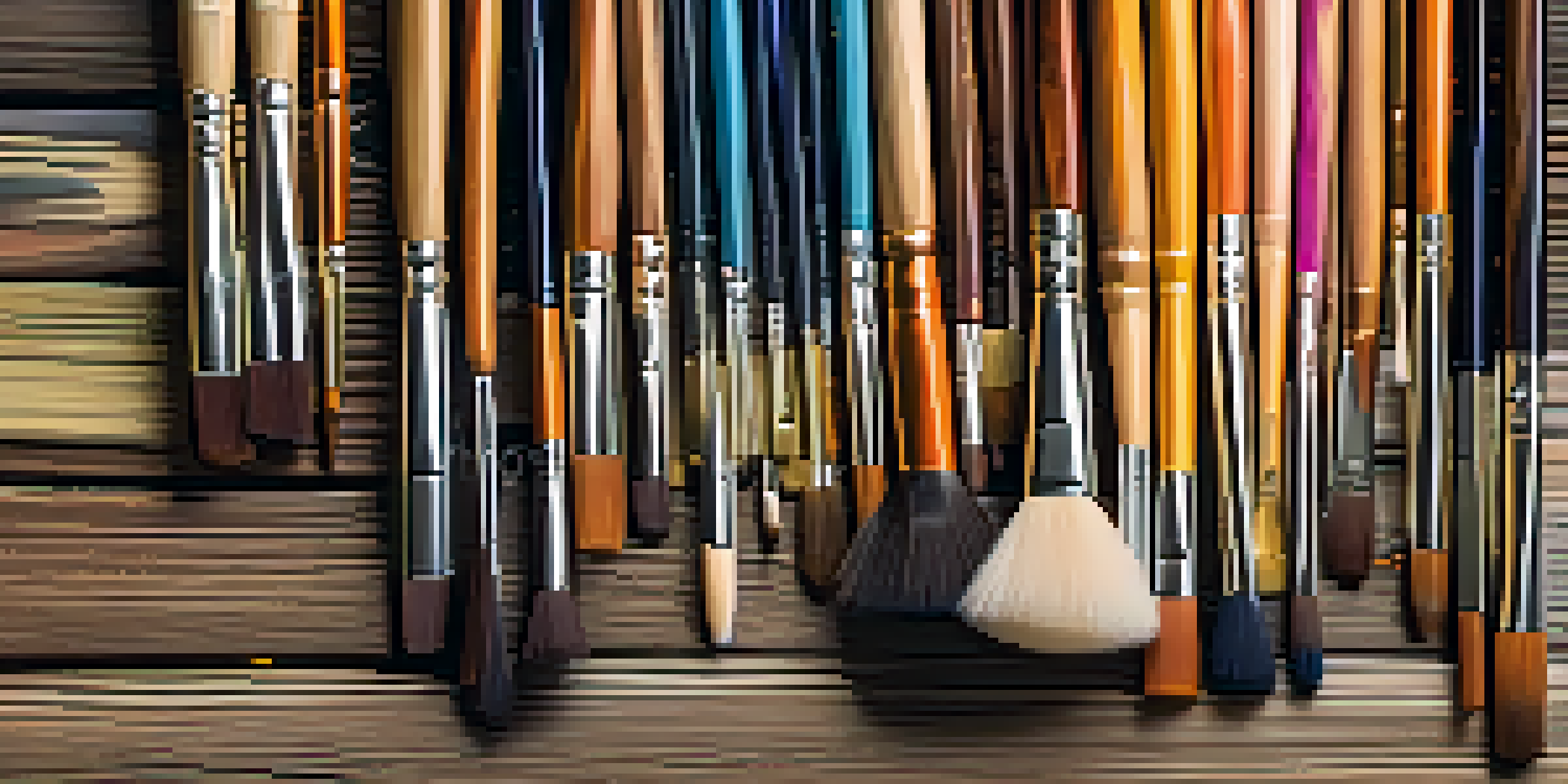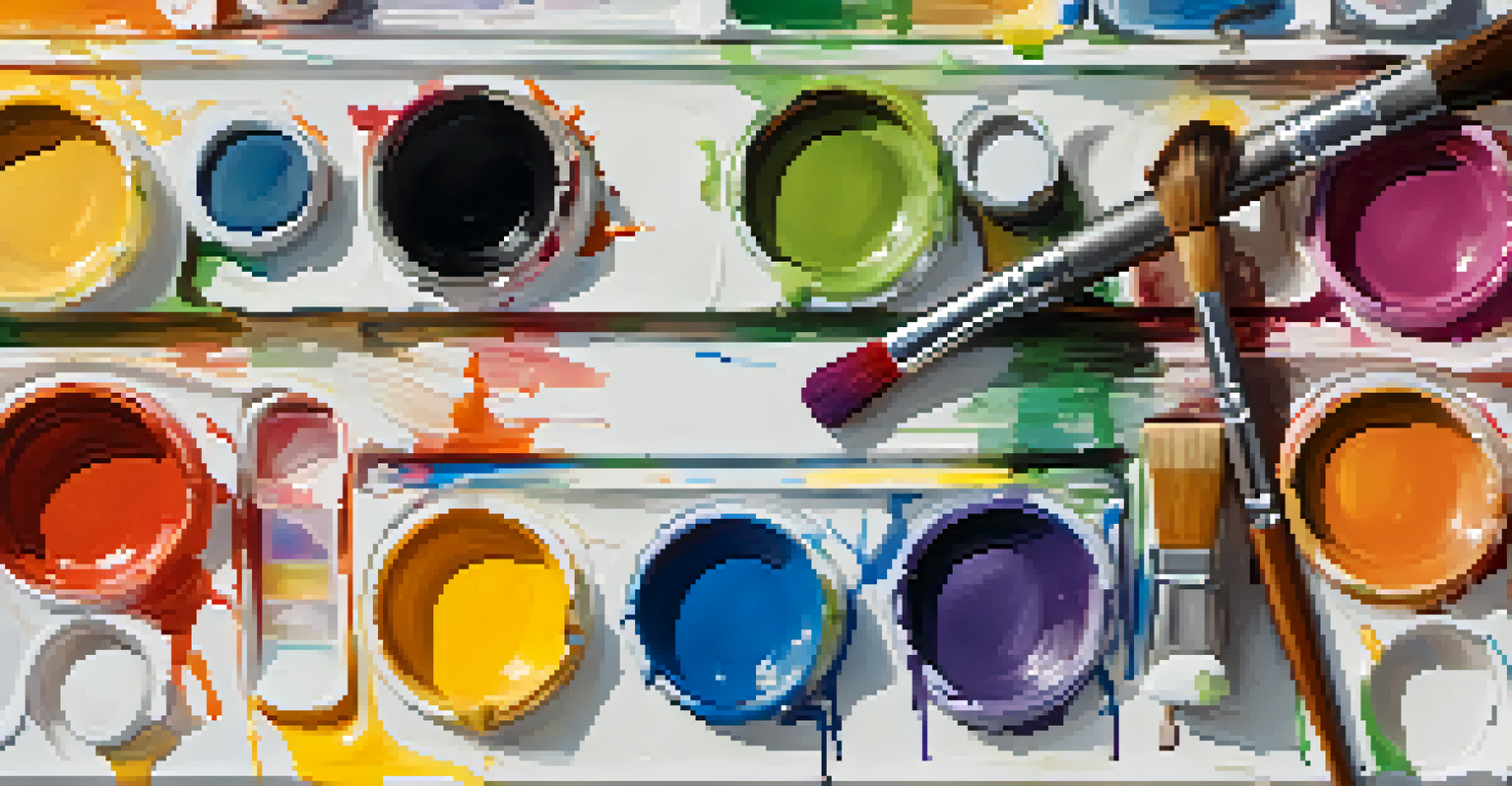Essential Tools Every Painter and Drawer Should Have on Hand

The Importance of Quality Brushes for Every Artist
Brushes are an artist's best friend, serving as the primary tool for applying paint or creating strokes in drawing. Whether you're painting with watercolors or acrylics, having a variety of brush types can significantly affect the outcome of your artwork. Different shapes, sizes, and bristle materials offer unique effects, so investing in quality brushes can make all the difference in your creative process.
Every artist dips his brush in his own soul, and paints his own nature into his pictures.
For example, a flat brush is excellent for bold strokes and filling in larger areas, while a round brush is perfect for detailed work and fine lines. As you experiment with different brushes, you'll discover which ones suit your style and techniques best. Remember, a good brush can elevate your work from amateur to professional in a matter of strokes.
Don't forget to maintain your brushes properly! Cleaning them after use and storing them correctly will prolong their life and keep them performing at their best. This investment in your tools will pay off in the quality of your art.
Essential Sketchbooks: Your Creative Playground
A sketchbook is more than just blank pages; it's a space for experimentation and idea generation. Every artist needs a reliable sketchbook to jot down thoughts, sketch out concepts, or practice techniques. The beauty of a sketchbook lies in its ability to capture spontaneous creativity without the pressure of perfection.

Whether you prefer a spiral-bound book or one with a hard cover, choose a sketchbook that suits your style. Some artists love the feel of textured paper for pencil work, while others may prefer smoother surfaces for ink or watercolor. The right sketchbook can inspire you to draw more frequently, helping you hone your skills over time.
Quality Brushes Enhance Artwork
Investing in a variety of quality brushes can significantly elevate your artistic results and techniques.
Plus, your sketchbook can serve as a visual diary, documenting your artistic journey. Looking back at your older sketches can provide insight into your growth and spark new ideas for future projects, making it an invaluable part of your artistic toolkit.
Pencils and Charcoals: The Foundation of Drawing
Pencils and charcoals are essential for any artist, serving as the building blocks of drawing. They allow you to create everything from detailed sketches to bold, expressive lines. A good set of pencils—varying in hardness from soft (B) to hard (H)—gives you the versatility to achieve different effects and shading.
Art is not freedom from discipline, but disciplined freedom.
Charcoal, on the other hand, offers a rich, deep tone that can create stunning contrasts in your artwork. It’s especially popular for figure drawing or landscape sketches due to its ability to create dramatic shading and texture. Combining pencils and charcoals in your work can add depth and dimension.
Don't forget to keep your tools sharp and clean! A sharp pencil leads to precise lines, while a well-blended charcoal can create beautiful soft transitions. Investing time in mastering these basic tools will lay a solid foundation for your artistic endeavors.
Inks and Pens: Adding Precision to Your Art
Inks and pens are fantastic for artists looking to add precision and detail to their work. Whether you are working with fine liners, brush pens, or dip pens, each tool can produce unique effects that enhance your drawings. Inks can provide a bold, clean line that is perfect for outlines and intricate designs.
For instance, using a brush pen for calligraphy or expressive strokes can add a dynamic quality to your artwork. Experimenting with different inks can also lead to unexpected and delightful results, such as varying line thickness and texture. Additionally, using waterproof ink allows you to layer other mediums like watercolor without worrying about smudging.
Sketchbooks Foster Creativity
A reliable sketchbook serves as a playground for experimentation, helping artists capture ideas and track their growth.
Moreover, incorporating ink into your mixed media projects can elevate your work to new levels. The contrast between the fluidity of ink and the unpredictability of other materials can yield incredible outcomes, encouraging you to push your creative boundaries.
Easels: The Backbone of Your Painting Setup
An easel is an indispensable tool for any painter, providing a stable and adjustable surface to work on. It allows you to maintain a comfortable posture while painting, which can be crucial for long sessions. The right easel can support various canvas sizes and styles, whether you're working on a small watercolor piece or a large oil painting.
Portable easels are perfect for artists who love to paint en plein air, allowing you to capture the beauty of nature effortlessly. Meanwhile, studio easels offer sturdiness and versatility for more complex projects at home. Having a reliable easel can transform your workspace into a dedicated art studio, making it easier to focus on your creative process.
Additionally, an easel can help you view your artwork from different angles, allowing you to make necessary adjustments as you go. This flexibility encourages experimentation and can lead to surprising artistic breakthroughs.
Color Palettes: Mixing and Matching Like a Pro
A color palette is essential for any painter, allowing you to mix and match colors to achieve the desired effect in your artwork. Having a dedicated palette—whether it’s a traditional wooden one or a disposable paper palette—makes it easy to experiment with different hues and combinations. This practice can enhance your understanding of color theory and help develop your unique style.
For instance, using a limited color palette can challenge you to be creative with fewer options, resulting in harmonious and cohesive pieces. It can also save you time during your painting sessions, as you won't spend excessive time choosing colors. Plus, mixing colors on a palette allows for the creation of custom shades that can truly bring your work to life.
Finishing Touches Preserve Art
Using varnishes and fixatives protects and enhances your artwork, ensuring it lasts while showcasing your creativity beautifully.
Remember, your palette is a reflection of your artistic personality. Over time, you'll learn which colors resonate with you and how to use them effectively, adding another layer of depth to your artwork.
Finishing Touches: Varnishes and Fixatives
Once your masterpiece is complete, it’s time for the finishing touches, and that’s where varnishes and fixatives come into play. Varnishes protect your paintings from dust, UV light, and moisture, ensuring that your hard work stands the test of time. Whether you choose a glossy, satin, or matte finish, the right varnish can enhance the vibrancy of your colors and add depth to your work.
For drawings, a fixative is essential to prevent smudging and preserve the integrity of your artwork. Spraying a light coat of fixative can seal in your pencil, charcoal, or pastel work, allowing you to handle your pieces without fear of ruining them. It’s a simple step that can make a significant impact on the longevity of your art.

Incorporating these final elements into your artistic routine not only protects your work but also showcases it beautifully. Remember, the finishing touch can elevate your artwork from simple to stunning.